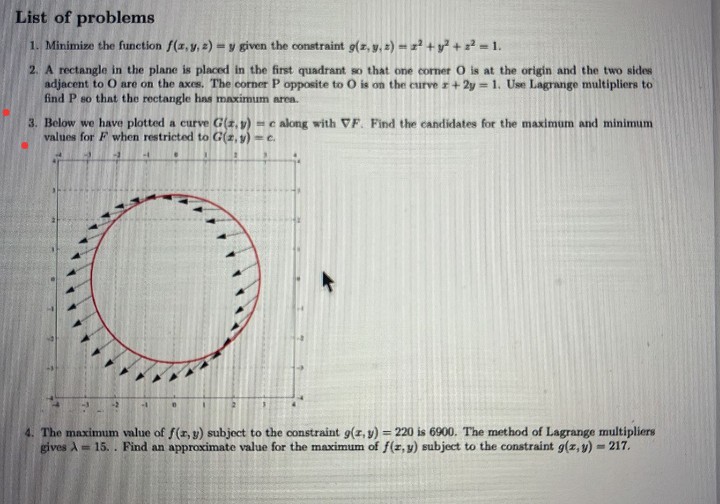Minimize the function f(x, y, 2) = y given the constraint g(z, y, 2) - z² + y² +-1.
Minimize the function f(x, y, 2) = y given the constraint g(z, y, 2) - z² + y² +-1.
Linear Algebra: A Modern Introduction
4th Edition
ISBN:9781285463247
Author:David Poole
Publisher:David Poole
Chapter2: Systems Of Linear Equations
Section2.4: Applications
Problem 17EQ
Related questions
Question
Solve q3 only

Transcribed Image Text:List of problems
1. Minimize the function f(z,y, 2) = y given the constraint g(z, y, 2) = z +y + = 1.
2. A rectangle in the plane is placed in the first quadrant so that one comer O is at the origin and the two sides
adjacent to O are on the axes. The corner P opposite to O is on the curve r+ 2y = 1. Use Lagrange multipliers to
find P so that the rectangle has maximum area.
3. Below we have plotted a curve G(z. v) = c along with VF. Find the candidates for the maximum and minimum
values for F when restricted to G(2, y) -e.
4. The maximum value of f(r, y) subject to the constraint g(z, y) = 220 is 6900. The method of Lagrange multipliers
gives A = 15. . Find an approximate value for the maximum of f(z, y) subject to the constraint g(z, y) = 217.
%3D
Expert Solution
This question has been solved!
Explore an expertly crafted, step-by-step solution for a thorough understanding of key concepts.
Step by step
Solved in 2 steps with 1 images

Recommended textbooks for you

Linear Algebra: A Modern Introduction
Algebra
ISBN:
9781285463247
Author:
David Poole
Publisher:
Cengage Learning

Algebra for College Students
Algebra
ISBN:
9781285195780
Author:
Jerome E. Kaufmann, Karen L. Schwitters
Publisher:
Cengage Learning

Linear Algebra: A Modern Introduction
Algebra
ISBN:
9781285463247
Author:
David Poole
Publisher:
Cengage Learning

Algebra for College Students
Algebra
ISBN:
9781285195780
Author:
Jerome E. Kaufmann, Karen L. Schwitters
Publisher:
Cengage Learning